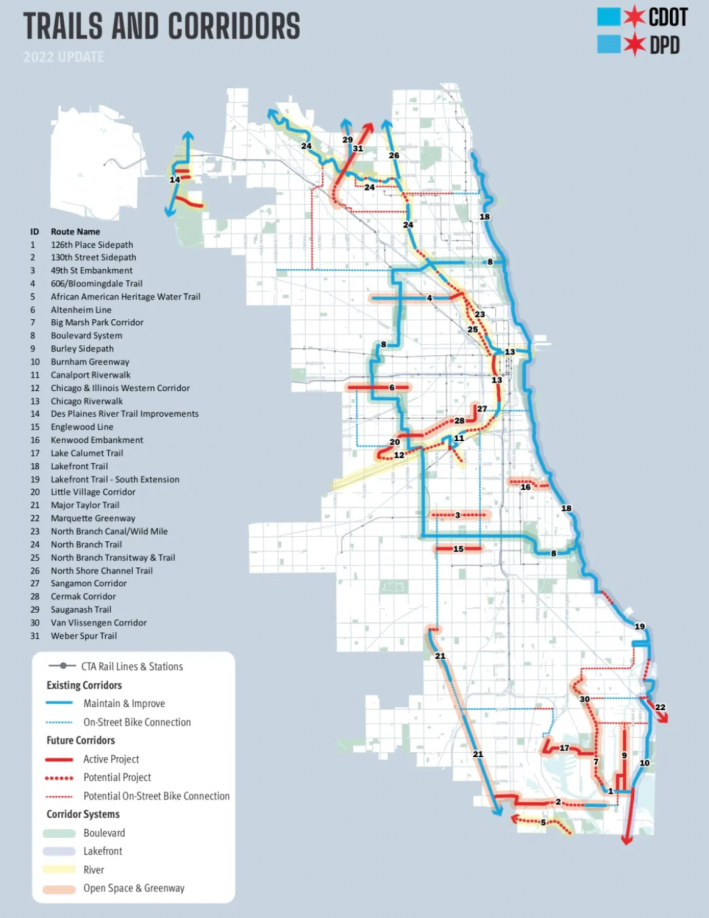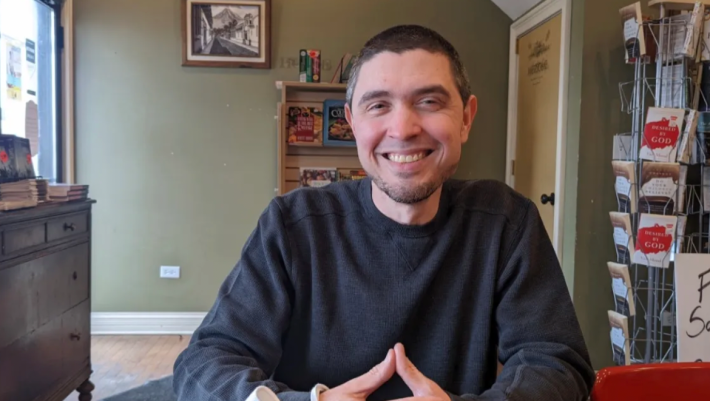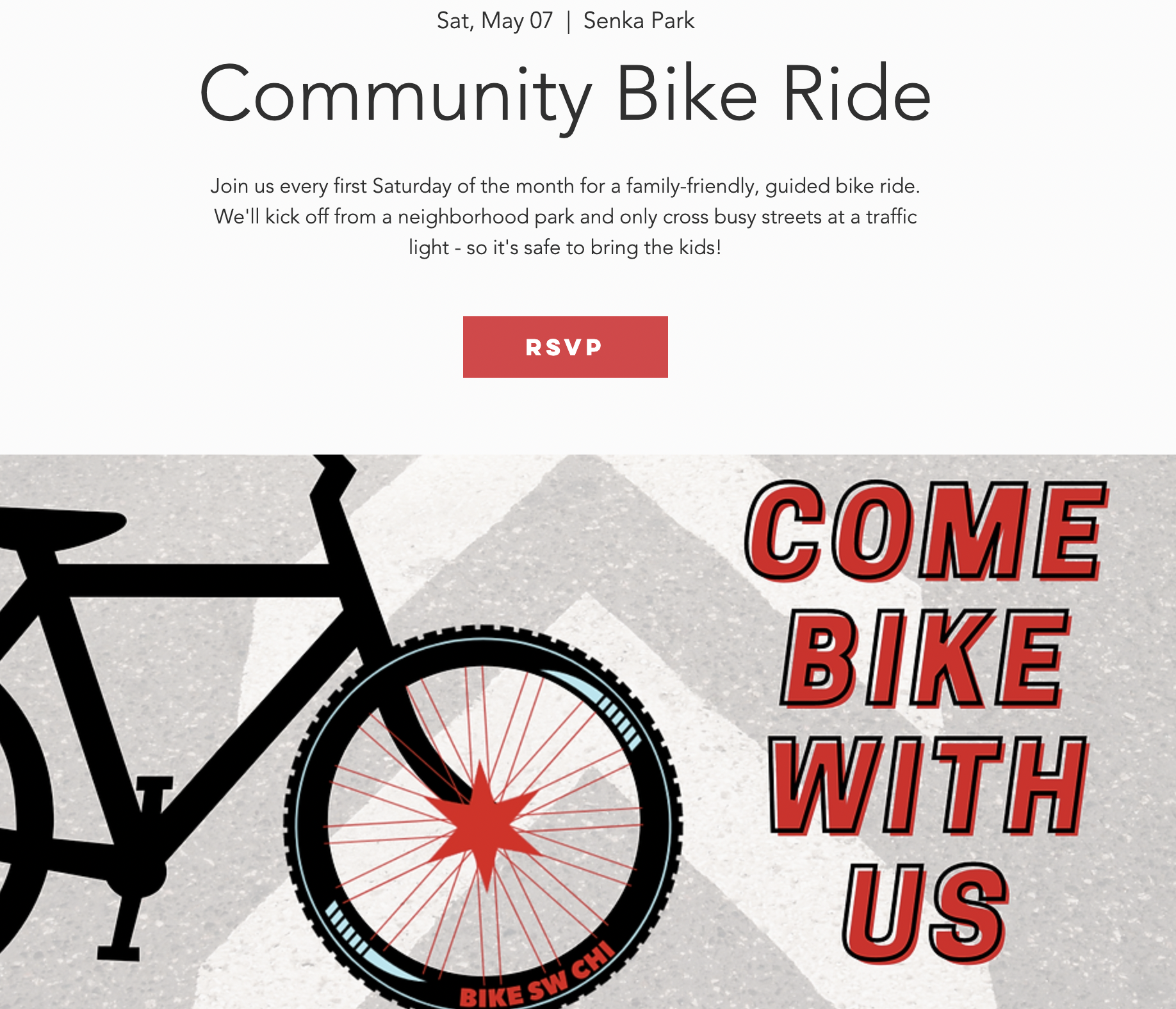Para leer este artículo en español, haga clic aquí.
I first learned of the Southwest Collective (SW) through social media when the community-building organization was partaking and organizing COVID mutual aid for residents of the Southwest side. Last month, I sat down with the SW bike group leader, Dixon Galvez-Searle (DSG), to talk about his work strengthening the sense of community through leading bike rides on the Southwest side.
The Collective focuses on the neighborhoods of Archer Heights, Ashburn, Back of the Yards, Brighton Park, Clearing, Gage Park, Garfield Ridge, Scottsdale, The Lawns, and West Elsdon. Through their advocacy work, they hope to break the barriers that keep the neighborhoods apart. The Southwest side is often overlooked in active transportation planning. Although the city recently unveiled a vision for a connected network of trails and corridors, the plan leaves much to be desired on the Southwest side with zero active projects and no plans for development of Archer Avenue.
Archer is a street identified as a spoke route in the Chicago’s Streets for Cycling Plan 2020. In the plan, a spoke route is supposed to increase bicycle commuting by providing a safe and continuous connection to and from the Loop. Currently the biking conditions on Archer deter people from biking due to high vehicle speeds and debris. Despite hostile streets, the Southwest Collective is building a coalition of Southwest residents to prove that there are people eager to bike.

Ruth Rosas: How did Southwest Collective begin?
Dixon Galvez-Searle: We started at the beginning of 2019. My wife and I have lived in Archer Heights for 12 years and we lived in McKinley Park before that. We wanted to kind of be civically engaged and involved with the community. We had been involved with some civic associations and things going on with schools, but we wanted to start a community organization that focused on the livability of the neighborhood. My wife wanted to see what would happen if we started something so we invited everybody that we knew that we thought might be interested. It grew from there.
RR: What is the focus of the Collective today?
DGS: There’s been a shift since COVID-19. When we first started, we didn’t really start with a program or a focus, we wanted to create a space where people came together and do what they wanted to do without running into roadblocks because it didn’t fit a specific focus. We gave people an opportunity to give ideas and see what could come out of those ideas. Little free libraries and community bike rides were the results. We also started a big event that we call Freebies For Families.
RR: What is Freebies For Families?
DGS: In 2019, there was a pregnant woman who went to a Southwest neighborhood to pick up baby clothes. She was murdered. It got national attention and it was very close to home for us. When we saw that, we were horrified like everyone else. So Freebies For Families started as a public space for people to exchange stuff. If someone wants to drop something off or pick something up, we can do that.
After that in 2020, we started connecting with groups that were doing mutual aid and the Chicago Food Sovereignty Coalition. We started doing food drives. We did COVID specific things like vaccination work as well.
RR: How do you get the word out to Southwest residents?
DGS: It’s mostly on social media. My wife has a marketing background, and she has been able to build up digital advertising, branding, and social media presence. She’s been instrumental in terms of getting us a following on Facebook, Twitter, Instagram.
RR: I first heard about Southwest Collective through Twitter when you all were doing COVID-related mutual aid.
DGS: Yeah, we were out there trying to do things for the Southwest side because it’s such a populous area, right? There are so many people who live in the Southwest side. But for a lot of people, they see the Southwest side as something they see from the Orange Line when they are going to Midway. They see a lot of houses, a lot of bungalows, but they don't necessarily know what’s going on here.

RR: What started the bike rides?
DGS: The main objective about the collective was to have a group of people who could start whatever project you wanted, as long as you organized it. I was on the board at the time and I had been biking in the city for my whole life and it’s something I really enjoy. So I thought well, that’ll be my thing. But I know the streets around the Southwest Side can be very inhospitable to bikes, especially Archer, Pulaski, and Cicero. These streets are essentially highways. If somebody is new to biking, there’s no way you are going to bike down these streets. You have to plan your bike ride, especially if you are traveling from North to South and vice versa because many of the streets are not built for anything but cars and trucks going through. So that has always been a bit of my frustration; biking down here is harder than it needs to be. I know that if you are going to bike in the city, you have to be a little hard-headed because the streets are not built for bikes. There are barriers to getting around on your bike, but what I really wanted to do was try to build up a community and encourage people to ride a bike on the Southwest side. I also wanted to connect current riders who may not realize just how many other riders there are on the Southwest Side. If nothing else, it’s about getting people out once a month to meet each other.
RR: What is a typical bike ride like?
DGS: Our overall intention is to bring neighbors together. We rotate between meeting up at different parks in the area. We generally stick with a particular park for 2 months. We hold the rides on the first Saturday morning of the month. Our next ride is May 7th, and we ride until November. The entire ride happens on side streets. Sometimes it can be challenging to plan routes that cross major streets, but we wanted to show people how to bike through their neighborhood and go into the next neighborhood as well. The rides are also family-friendly and accessible to a broad range of people.
RR: Do you partner with other bike groups or organizations?
DGS: Yes, we worked with Working Bikes a bit. They gave us a donation of 10 kids bikes. We gave some away at Freebies For Families, we raffled some off at the rides, and we gave one to a daycare. We also talked to them about possibly doing a virtual bike maintenance workshop.
RR: What are the local bike shops in the Southwest side?
DGS:I don’t know many over here. There’s Carmen’s Schwinn in Garfield Ridge. When we did our ride in Garfield Ridge last summer, they were enthusiastic and helped spread the word. There is also a new one near 47th and California called Sanchez Bike Shop. Sanchez also has a shop in Little Village.
Last summer, I got a flat tire and I thought, “I’m going to fix it myself.” I went to Target, the closest store for me to get a tube, but they didn’t have the right size. Then I looked online and I bought the wrong size. Finally, I just took the tire off and brought it into Carmen’s and they fixed it in five minutes. Having a bike shop close to you is crucial because eventually something is going to happen to your bike.
RR: You’re right, but I’ve never seen a chamber of commerce or business coalition talk about a bike shop missing from our neighborhoods. Do you see more people riding bikes now?
DGS: Yeah I have. I mean maybe I’m noticing it more, but I have seen more people on Divvys since the expansion so that’s encouraging. Divvy did reach out to us last summer and asked for locations for stations. We did a couple of community forums with them so people could provide feedback. The expansion was long overdue.
RR: What are some of your wishes in terms of bike infrastructure on the Southwest Side?
DGS: When I think of bike lanes, Archer is a priority for me. For most of our communities in the Southwest, Archer is the main thoroughfare. It connects everything. If I’m riding anywhere that’s not immediately south of me, Archer is the one street that goes all the way through, because many streets run into an intermodal facility or industrial yard at some point. Last year, I took footage from Harlem all the way to State on Archer to see what points are particularly troublesome. In the last few years, there have been at least two people who were killed on bikes on Archer. It’s totally possible to have physically separated bike lanes, at least in some parts. Archer is 4 lanes for the majority of its length and parking is pretty empty in some parts. There are also lots of opportunities for adding some stop signs.
RR: What other issues do you see in the area that create barriers for bicycling.
DGS: I live just south of Hilco and I know activists in Little Village have been raising the alarm about the impacts of this new freight facility. I mean it’s kind of obvious, there is so much industry concentrated here, and truck traffic is emitting so much pollution. Trucks also wreck the streets and are a serious threat to traffic safety.
RR: Is there anything else you want people to know about the Southwest Collective or the bike rides?
DGS: I think the main thing I’d like people to know is that biking is an option on the Southwest side. There are all sorts of things that would make you think otherwise. It’s a pretty common mindset that riding your bike in the area is dangerous, but I think just getting out on your bike for a short ride around the neighborhood is step one. The more that happens, the more we’re going to be able to demand that streets be built for more than just the trucks that come through our neighborhoods and people passing through. Our streets can be built for walking and riding for the people who live in these neighborhoods.
To join and get involved with the Southwest Collective rides, check out their calendar.



